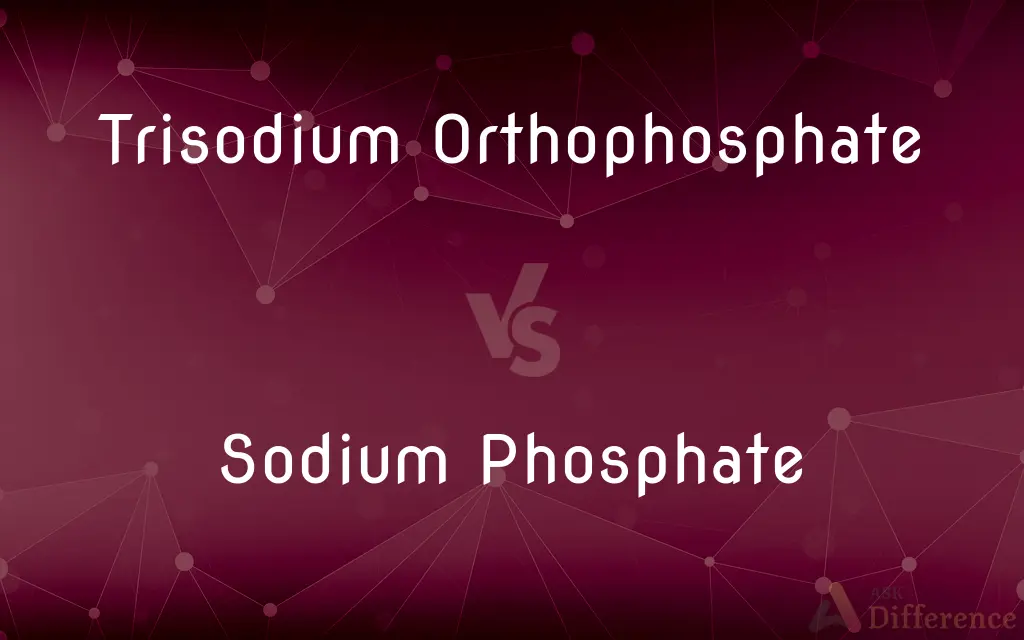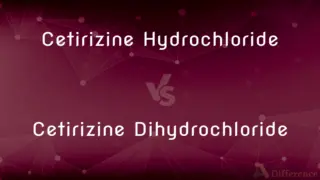Trisodium Orthophosphate vs. Sodium Phosphate — What's the Difference?
By Tayyaba Rehman — Published on January 8, 2024
Trisodium orthophosphate is a specific form of sodium phosphate with three sodium atoms (Na₃PO₄), while sodium phosphate generally refers to a group of sodium salts of phosphate.

Difference Between Trisodium Orthophosphate and Sodium Phosphate
Table of Contents
ADVERTISEMENT
Key Differences
Trisodium orthophosphate, with the chemical formula Na₃PO₄, is a specific compound in the larger group of sodium phosphates. It contains three sodium ions and one phosphate ion. Sodium phosphate broadly refers to any sodium salt of phosphoric acid and includes various forms such as monosodium phosphate (NaH₂PO₄), disodium phosphate (Na₂HPO₄), as well as trisodium orthophosphate.
In trisodium orthophosphate, all hydrogen atoms in phosphoric acid are replaced by sodium, resulting in a highly alkaline compound. Other sodium phosphates, depending on their sodium to phosphate ratio, can have different pH levels, ranging from acidic to alkaline. For instance, monosodium phosphate is more acidic, while disodium phosphate is moderately alkaline.
Trisodium orthophosphate is commonly used in industrial applications, including as a cleaning agent, water softener, and in food processing as an emulsifier or buffer. Sodium phosphates in general are used in similar applications but vary based on their specific properties. For example, monosodium and disodium phosphates are often used as sequestrants and pH adjusters in food.
In terms of solubility, trisodium orthophosphate is highly soluble in water and forms an alkaline solution. The solubility and reaction of other sodium phosphates in water depend on their specific composition. Some may be less soluble or form solutions with different pH values.
Both trisodium orthophosphate and other forms of sodium phosphate can have various health and environmental implications. Trisodium orthophosphate is generally considered safe in small amounts but can be irritating to skin and eyes. The safety of other sodium phosphates similarly depends on their concentration and exposure levels.
ADVERTISEMENT
Comparison Chart
Chemical Formula
Na₃PO₄
Various (e.g., NaH₂PO₄, Na₂HPO₄)
PH Level
Highly alkaline
Ranges from acidic to alkaline
Common Uses
Cleaning agent, food processing
Sequestrants, pH adjusters in food
Solubility
Highly soluble in water
Varies depending on the compound
Health Implications
Safe in small amounts, can be irritating
Depends on concentration and type
Compare with Definitions
Trisodium Orthophosphate
Food Additive: Used as an emulsifier in food.
Trisodium orthophosphate helps maintain the texture of processed foods.
Sodium Phosphate
Sequestrant: Binds with metal ions in solutions.
As a sequestrant, sodium phosphate helps improve water quality.
Trisodium Orthophosphate
Water Softener: Acts as a water softening agent.
It's added to detergents to soften hard water.
Sodium Phosphate
Laxative Properties: Used as a laxative in medicine.
Certain sodium phosphate compounds are used for bowel cleansing.
Trisodium Orthophosphate
Alkaline Compound: A highly alkaline sodium salt.
Trisodium orthophosphate is used to increase the pH of solutions.
Sodium Phosphate
Versatile Uses: Found in foods, detergents, and medicines.
Sodium phosphate's versatility is seen across various industries.
Trisodium Orthophosphate
Buffering Agent: Serves as a buffer in solutions.
It's used to stabilize the pH in chemical solutions.
Sodium Phosphate
General Term for Salts: Refers to a group of sodium salts.
Sodium phosphate is used as an additive in many food products.
Trisodium Orthophosphate
Cleaning Agent: Used in industrial cleaning.
Trisodium orthophosphate effectively removes grease and stains.
Sodium Phosphate
PH Adjuster: Adjusts pH levels in solutions.
Sodium phosphate compounds are added to balance the acidity in foods.
Common Curiosities
Why is Trisodium Orthophosphate used in detergents?
Its ability to soften water and emulsify grease makes it effective in cleaning.
Is Trisodium Orthophosphate safe for consumption?
In small amounts as a food additive, it is generally considered safe.
Can Sodium Phosphate supplements cause side effects?
Overconsumption can lead to health issues like kidney damage.
Are Sodium Phosphate additives necessary in food?
They are used to improve texture, shelf life, and flavor stability.
What industries commonly use Trisodium Orthophosphate?
It's used in food processing, cleaning, and water treatment industries.
Can Sodium Phosphate be used in organic farming?
It depends on the specific type and regulations of organic certification.
Can Trisodium Orthophosphate cause skin irritation?
Yes, it can be irritating to the skin and eyes in high concentrations.
Can Trisodium Orthophosphate treat hard water?
Yes, it's effective in reducing water hardness.
How does Trisodium Orthophosphate affect water pH?
It raises the pH level, making water more alkaline.
Are there alternatives to Trisodium Orthophosphate in cleaning?
Yes, there are alternative cleaning agents, especially in eco-friendly products.
Is Sodium Phosphate harmful to the environment?
Excessive use can lead to environmental concerns like eutrophication.
Are Sodium Phosphate compounds naturally occurring?
Some forms can occur naturally, while others are synthetically produced.
Is Trisodium Orthophosphate the same as Sodium Triphosphate?
No, they are different compounds, although both are used in similar applications.
Is Sodium Phosphate essential in processed foods?
While not essential, it's commonly used to improve quality and longevity.
Can Sodium Phosphate be used in baking?
Yes, it's used as a leavening agent and stabilizer in baked goods.
Share Your Discovery

Previous Comparison
Gonal F vs. Follistim
Next Comparison
Cetirizine Hydrochloride vs. Cetirizine DihydrochlorideAuthor Spotlight
Written by
Tayyaba RehmanTayyaba Rehman is a distinguished writer, currently serving as a primary contributor to askdifference.com. As a researcher in semantics and etymology, Tayyaba's passion for the complexity of languages and their distinctions has found a perfect home on the platform. Tayyaba delves into the intricacies of language, distinguishing between commonly confused words and phrases, thereby providing clarity for readers worldwide.












































